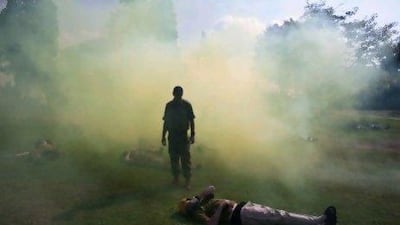In 1992, Benjamin Netanyahu, then an Israeli parliamentarian, warned that Iran was between three and five years away from producing a nuclear weapon.
The threat, he insisted, had to be "uprooted by an international front headed by the United States".
Fast forward two decades. Mr Netanyahu, now Israel's prime minister, is warning that the Islamic republic will be on the brink of developing the bomb by the middle of next year.
US officials, however, said in August that Washington believes Iran is not on the verge of a having a nuclear weapon and has not made the strategic decision to develop one.
Nevertheless, the US believes Iran is keeping the option open by nurturing various capabilities to do so - in particular by pressing ahead with its uranium enrichment programme in contravention of several United Nations Security Council resolutions.
So how far is Iran from getting the bomb? Assuming, that is, Tehran wants one, an ambition it vehemently denies.
Timeline estimates are fraught with uncertainty because it is not known how advanced the Iranians may be in their suspected nuclear bomb research.
Most experts believe it would take Iran at least two years to assemble a single nuclear-tipped missile, if it chooses to weaponise its atomic programme.
Mr Netanyahu's calculations are seemingly based on when Iran could have enough medium- enriched uranium to make a sprint to produce enough weapon-grade material for one bomb. With provisos, many analysts agree with him that Iran could be in that position by next summer.
But even if Iran makes a dash to enrich its uranium stockpile to 90 per cent weapons-grade purity, it would probably need another six months to assemble a "crude nuclear device", said Mark Fitzpatrick, a senior non-proliferation expert at the International Institute of Strategic Studies, a London think tank.
"And to produce a nuclear weapon that could be deliverable by a ballistic missile would take at least another year," he added. "So the total time is at least two years.
"And that is only for one weapon. It would be foolhardy for Iran to undertake the risk, only to produce one nuclear weapon."
Peter Jenkins, a British former ambassador to the UN's nuclear watchdog, the International Atomic Energy Agency (IAEA), agreed.
"Who on Earth would want to rely on just one bomb against Israel, knowing what the consequences would be?" he asked. "So why the hysteria?"
Israel, the Middle East's sole - if undeclared - nuclear-armed superpower is thought to have as many as 200 nuclear warheads.
Mr Fitzpatrick's timeline, based on a review of open-source materials and discussions with government experts, tallies with a recent report signed by nearly three dozen high-ranking national security officials from both political parties in the US.
They believe Iran would need between one and four months to produce enough weapons-grade uranium for a single nuclear device.
"Additional time - up to two years according to conservative estimates - would be required for Iran to build a nuclear warhead that would be reliably deliverable by a missile," said the report, which was published by the Iran Project last month.
Among those endorsing the study - which was based on publicly available documents, including unclassified intelligence reports -- were two former national security advisers, Zbigniew Brzezinski and Brent Scowcroft, the former undersecretary of state, Thomas Pickering, and the retired general, Anthony Zinni.
Experts, moreover, say any attempt by Tehran to "break out" and make weapons-grade uranium would be spotted by the International Atomic Energy Agency (IAEA), which monitors Iran's uranium stockpile.
Leon Panetta, the US defence secretary, said last month that Washington also has "pretty good intelligence" on Iran and would know if it decides to make a nuclear weapon. In that case, the US would have "a little more than a year" to act to stop it - and, he vowed, has the firepower to do so.
Iran has produced more than 6.8 tonnes of uranium refined up to five per cent purity since 2007, a low level of purity that is sufficient to fuel nuclear power reactors. That amount, if processed much further, could be used for a handful of weapons, experts say.
"Iran has had the nuclear material for at least three bombs for years, not months, but has made no move in that direction and shown no sign of intending to do so," said Mr Jenkins.
Iran, however, has further enriched some of that stockpile to 20 per cent to power a medical research reactor in Tehran, which produces isotopes for cancer patients. It is a short technical leap to purify this medium-enriched uranium into weapons-grade fuel.
The IAEA reported in August that Iran has produced about 190 kilograms of 20 per cent-enriched uranium: just about enough, experts say, to fuel one bomb if purified further.
But, the IAEA said, Iran has converted more than a third of that stockpile into oxide form, a portion of which was made into fuel plates for the Tehran reactor, leaving Iran in August with a cache of just over 90kg of medium-enriched uranium.
So, analysts say, the US and five other world powers still have time to try to rein in Iran's nuclear programme peacefully through coercive diplomacy.
And, as Iran's currency crisis showed in recent days, western-imposed sanctions are clearly hurting Tehran's economy.

